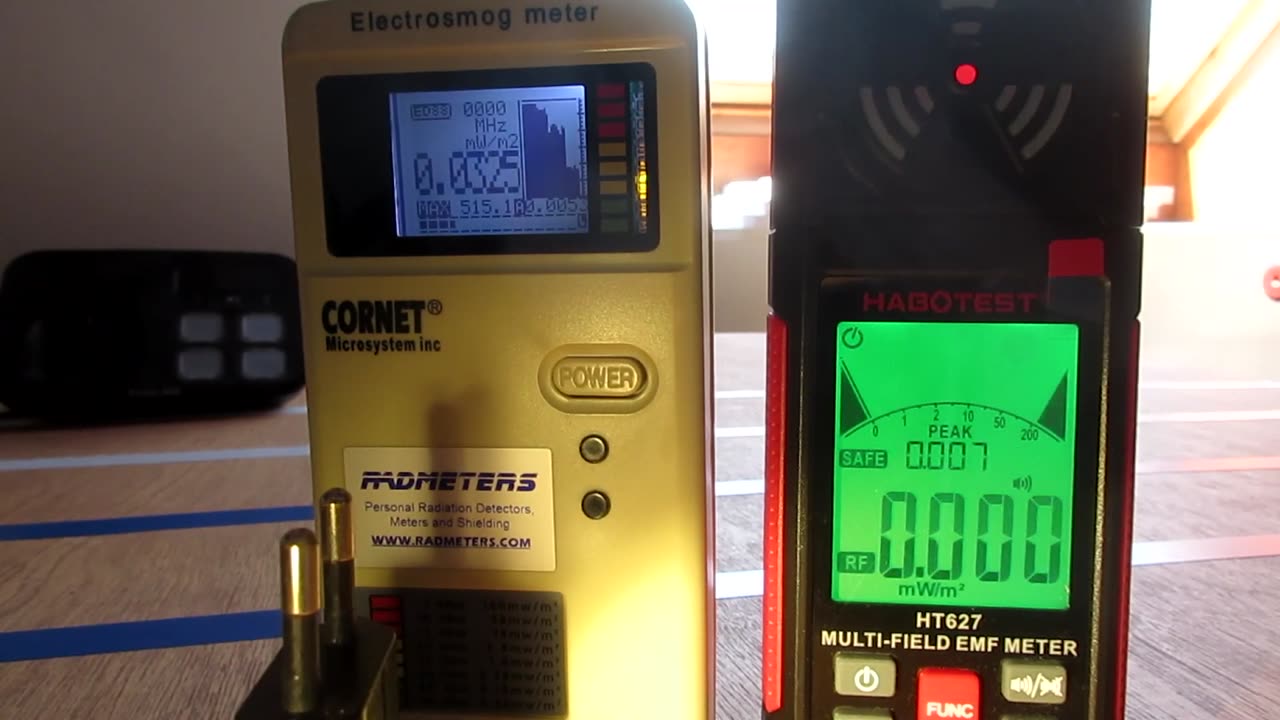Premium Only Content

Habotest HT627 multi-field EMF meter - looks like Hound-200
My conclusion:
I cannot recommended this device to EMF sensitive people,
but it can be useful to find certain EMF if the EMF is high and it's a cheap device.
Habotest HT627 ---- https://www.aliexpress.com/w/wholesale--Habotest-HT627-.html
EMFfields PF5
Gigahertz ME3851a ---- https://gigahertz-solutions.com/Measurement/Low-Frequency
Cornet ED88T
EMF-390-V2
Erickhill RT100 ---- (Be careful: the magnetic mode of this Erickhill (for example) is not suited for EMF sensitive people: watch video 8/13 and 9/13). So make sure you know what each device listed here can and cannot do before you buy it, they all have minor or major flaws, that can all be seen in my videos.)
My thoughts and review:
I have so often heard someone say in a "review video" of some new EMF meter that it's "very accurate". This has to stop. Those that say such things never test the device they promote against quality EMF meters or scopes to proof this. When I say it isn't, some people still keep saying to me the device is "accurate" because they say they compared this (or that) EMF meter against other EMF meters they own (they don't show on video though). However, those that claim such things:
a) often don't know what they are talking about, they only own low quality devices so they are just
comparing one weak device with a weak sensor against another weak device with a weak
sensor. They are deceived and perpetuate this.
b) or they are lying to promote a product. You can clearly see that the other EMF meters in this
video performed much better. Lies are very harmful.
The problem is that people who don't know much about EMF meters often believe reviews.
On Aliexpress you can see how many of a certain device was sold, so you can see how many people have bought a certain EMF meter that misses lot's of EMF.
- The magnetic field mode lacks frequency range (and/or sensitivity), hence it can overlook lot's of EMF, which is why it's definitely not suited for EMF sensitive people. The manual states that it detects up to 1kHz max. This is more honest than a lot of other manuals of devices claim. The magnetic fields from the mouse were likely above this range (and/or this meter lacks serious sensitivity). This shows the problem with most EMF meters, you don't get the real picture. You may think there is no EMF, while in reality there is lot's of EMF. So this meter is more suited to find magnetic fields in the 50/60Hz range mostly.
- The electric mode performs very poorly, pretty much useless for EMF sensitive people,
so for other people: if a source is very strong you can find it with this device.
The manual states 1V/m - 2000V/m. but as seen this is very far from the truth.
- The RF mode of the tested device could have some use for EMF sensitive people on a very low budget, but it's not sensitive enough, it will not provide enough info to show you the real situation. Devices like these often do not measure all RF within the claimed frequency range by the manual.
The radiation light on top is a gimmick, it doesn't seem to have any useful purpose.
The "Trend Graph" is copied from the Trifield TF2.
Just like the Trifield TF2, this EMF meter also makes a ticking sound when it measures nothing,
this is only useful to know that the sound function is enabled, but otherwise it serves no purpose, I prefer that an EMF meter doesn't tick when it doesn't detect EMF, like my Gigahertz ME3851a does.
This Habotest doesn't have a true sound function like the Cornet has.
A true sound function adds more useful information.
The Habotest didn't wanna power up at first, when batteries were put in,
but after some tries it did. After this it powered up every time. Strange.
I used this specific mouse in this video because it emits lot's of magnetic in a certain frequency range that many EMF meters often are unable to detect. I think that not all wireless mice will emit the same EMF and likely not all mice emit this much magnetic (I don't know though, I haven't tested many wireless mice), but you can see that it is possible that a small product like a wireless mouse emits very strong magnetic fields (in addition to a lot of RF).
--------------------------------------
Studies:
EMF sensitivity:
https://www.dropbox.com/scl/fi/7l57eb2os9e984pv6yzj8/?rlkey=t36av69gzn6rne9mkxjmw2wea
EMF Bio-effects:
https://www.dropbox.com/scl/fi/frxuwn6omaijsrvdvebab/EMF-effects.pdf?rlkey=e3ir2vyj0igw6fjo1o74gch2x&e=1&st=xm2oe6hv
--------------------------------------
-
 2:00:20
2:00:20
Glenn Greenwald
10 hours agoThe View from Moscow: Key Russian Analyst Aleksandr Dugin on Trump, Ukraine, Russia, and Globalism | SYSTEM UPDATE #414
87.4K29 -
 1:10:55
1:10:55
Donald Trump Jr.
7 hours agoBREAKING NEWS: My Father Revokes Biden-Maduro Oil License, LIVE with Maria Corina Machado | Triggered Ep.220
174K185 -
 1:25:29
1:25:29
Sarah Westall
6 hours agoX-Files True History, Project Blue Beam, Cabal Faction War w/ Former FBI Agent John DeSouza
64.9K5 -
 7:03:49
7:03:49
Dr Disrespect
13 hours ago🔴LIVE - DR DISRESPECT - NEW PC VS. DELTA FORCE - MAX SETTINGS
153K26 -
 49:04
49:04
Lights, Camera, Barstool
1 day agoIs The Monkey The Worst Movie Of The Year?? + Amazon Gets Bond
62.3K4 -
 24:19
24:19
Adam Carolla
1 day agoDiddy’s Legal Drama Escalates, Smuggler Caught Hiding WHAT? + Philly Eagles & The White House #news
90.8K16 -
 10:12
10:12
Mike Rowe
2 days agoClint Hill: What A Man. What A Life. | The Way I Heard It with Mike Rowe
106K10 -
 1:31:52
1:31:52
Redacted News
8 hours agoBOMBSHELL! This is war! FBI whistleblowers reveal Epstein files being destroyed? | Redacted News
176K370 -
 48:55
48:55
Candace Show Podcast
9 hours agoSTOP EVERYTHING. They FINALLY Mentioned ME In The Blake Lively Lawsuit! | Candace Ep 152
154K127 -
 1:02:51
1:02:51
In The Litter Box w/ Jewels & Catturd
1 day agoWhere are the Epstein Files? | In the Litter Box w/ Jewels & Catturd – Ep. 750 – 2/26/2025
108K87